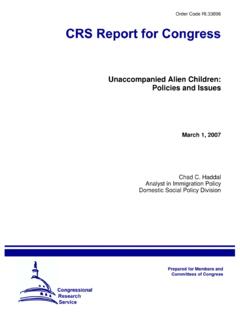Transcription of Department of Homeland Security Office of Inspector General
1 Department of Homeland Security Office of Inspector General Immigration and Customs Enforcement Policies and Procedures Related to Detainee Transfers OIG-10-13 November 2009 Office of Inspector General Department of Homeland Security Washington, DC 20528 November 10, 2009 MEMORANDUM FOR: John T. Morton Assistant Secretary Immigration and Customs Enforcement FROM: Richard L. Skinner Inspector General SUBJECT: Letter Report: Immigration and Customs Enforcement Policies and Procedures Related to Detainee Transfers (OIG-10-13) We reviewed Immigration and Customs Enforcement (ICE) detainee transfer policies and procedures in response to a request from nongovernmental organizations.
2 These organizations reported that some transfers have not complied with ICE National detention Standards and have created hardships for detainees. Our objective was to determine whether ICE detention officers properly justify detainee transfers according to ICE s standards. Transfer determinations made by ICE officers at the detention facilities are not conducted according to a consistent process. This leads to errors, delays, and confusion for detainees, their families, and legal representatives. Communication and coordination with the Department of Justice s Executive Office for Immigration Review (EOIR) immigration courts regarding detainee status can also be improved to eliminate confusion and delays. We are recommending that ICE establish a national standard for reviewing each detainee s administrative file prior to a transfer determination, and that it develop protocols with EOIR court administrators for exchanging hearing and transfer schedules.
3 The report contains two recommendations. ICE concurred with both recommendations. The full text of ICE s comments can be found in Appendix B. Within 90 days of the date of this memorandum, please provide our office with management s official response to the final report. The response should indicate corrective actions planned or taken; other supporting information; and, where appropriate, dates for achieving actions and the official responsible for implementation of the actions. We trust our recommendations will be of assistance as you conduct detention and removal operations and provide custody management during removal proceedings. Should you have any questions, please call me, or your staff may contact Carlton I. Mann, Assistant Inspector General for Inspections, at (202) 254-4100. Background The Immigration and Customs Enforcement (ICE) Office of detention and Removal Operations (DRO) is responsible for arresting, detaining, and removing inadmissible and deportable noncitizens (aliens) from the United States.
4 This includes aliens who are inadmissible or removable under the Immigration and Nationality Act (INA), guilty of certain crimes, in violation of the status in which they were admitted to the United States, or who have final orders of removal. Under the INA, certain inadmissible or removable aliens are subject to mandatory detention . Those not subject to mandatory detention may be detained, paroled, or released on bond or recognizance until a removal determination is complete. Since its creation in 2003, ICE has detained more than million individuals. ICE estimates that during FY 2009, more than 442,000 detainees will spend time in ICE custody, more than double its first year of operations. ICE transfers detainees to other detention facilities to prepare for final removal, reduce overcrowding, or meet the specialized needs of the detainee. Recently, the number of detainee transfers has increased because of insufficient bed space in some facilities.
5 Most detainees transferred owing to overcrowding are sent from eastern, western, and northern state detention facilities to locations in the southern and southwestern United States. In FY 2008, ICE had an average daily detention population of 31,244. Currently, ICE has a total bed capacity of 33,400 through use of its own service processing centers, contracted facilities, and local jails under Inter-governmental Service Agreements. ICE National detention Standards outline the policy, applicability, standards, and procedures for the transfer of a detainee. ICE must consider the detainee s Security requirements, medical needs, legal representation, and requests for a change in venue for the removal The detention standards state that ICE shall consider alternatives to transfer, especially when the detainee is represented by legal counsel and where immigration proceedings are ongoing. Legal representatives are required to notify ICE and the immigration court that they are the alien s legal counsel or The standards require that ICE notify the detainee s legal counsel no later than 24 hours after a transfer to another detention facility.
6 The Notice to Appear informs the alien of the reasons for arrest, the right to representation by counsel at no cost to the government, and the time and location of a removal proceeding. According to federal regulations, DRO must determine within 48 hours of an alien s arrest whether to issue a Notice to Appear and warrant of arrest and whether the alien will remain in custody or be released on bond or recognizance. In addition to the reasons for arrest and right to representation, a Notice to Appear must contain proof that the alien received the Notice to Appear, confirm that the alien received 1 On September 12, 2008, ICE introduced new Performance-Based National detention Standards and was implementing these new standards at detention facilities over a 12 month period. 2 For ICE, this is Form G-28; for the Executive Office for Immigration Review, this is Form E-28. 1 a list of free (pro bono) legal services available in the district where the hearing will be held, and indicate the immigration court in which it is filed.
7 At ICE s discretion, the Notice to Appear may indicate that the notice of the time and place of the removal proceeding will be given to the respondent once ICE has filed the Notice to Appear with an immigration court. Filing the Notice to Appear with the immigration court establishes jurisdiction for the removal proceeding. ICE is not required to file the Notice to Appear with the immigration court within a specified time after it has been served. ICE may decide for operational or other reasons to transfer a detainee from the jurisdiction where the detainee was arrested to a detention facility outside of that jurisdiction. For those detainees, ICE files the Notice to Appear with the immigration court that has jurisdiction over the receiving detention facility. Immigration judges from the Department of Justice s (DOJ) Executive Office for Immigration Review (EOIR) conduct removal proceedings. Detainees and legal counsel have the right to examine evidence against them, present evidence, and cross-examine witnesses.
8 Detainees may challenge their detention by requesting that an immigration judge with jurisdiction over the place of detention review and reassess ICE s custody or bond determination. Aliens determined to be inadmissible or removable may apply to the immigration court for relief, and may appeal a removal order with the DOJ Board of Immigration Appeals or the United States Court of Appeals. In FY 2008, 220 judges assigned to 56 immigration courts received 291,781 cases. An increase in cases and only a modest increase in immigration judges has created case backlogs and longer detainee wait times for proceedings. Because of the high case volume and logistical issues, many detainees appear before the court via a videoconference link from their detention facility. Results of Review ICE/DRO Can Improve the Detainee Transfer Process A detainee s Alien File (A-File) is an important part of the transfer process. The A-File contains information regarding the detainee and his or her movement through the detention process.
9 ICE detention officers review documentation in an A-File to make a determination regarding a detainee transfer. ICE detention standards state that, before transferring a detainee, ICE shall consider alternatives to transfer, especially when the detainee is represented by legal counsel and where immigration proceedings are ongoing. detention officers at five ICE Field Offices we visited do not consistently determine whether detainees have legal representation or a scheduled court proceeding when transferring detainees. EOIR judges and ICE detention officers in transferring jurisdictions and the judges and officers at receiving facilities said detainees with legal representation and scheduled court proceedings are being transferred to detention facilities outside of the scheduling court s jurisdiction. At one location, court and detention officers estimated that this occurs at least once a week. 2 ICE officials said that the transfer of detainees who already have a scheduled court hearing occurs because ICE has not received the EOIR notification of the detainee s scheduled court appearance.
10 ICE officials also said that inadvertent detainee transfers occur when the detainee s legal counsel submits a request for a custody or bond hearing with the immigration court before submitting a Form G-28, Notice of Entry of Appearance as Attorney or Representative, which announces the detainee s legal representative. In these cases, ICE said it is not aware that a detainee has legal representation or a scheduled court appearance at the time of transfer. The detention officers we interviewed were knowledgeable of the ICE detention standards. However, they were not consistently given written guidance regarding what specific information to assess in the detainee s A-file before making a transfer determination. ICE officials said that, based on geographic and other factors, directors of ICE Field Offices have discretion regarding the guidance and procedures they use to manage detainee transfer determinations. Transfer determinations at the ICE Field Offices we visited were not consistent.











